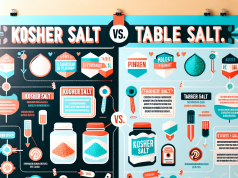Contents
Brown and White Pepper: A Comparison of Taste and Usage
Brown and white pepper are two popular types of pepper commonly used in cooking. While they both come from the same plant, they possess distinct characteristics that make them unique. Understanding the differences between these two types can elevate your culinary experience.
Taste
Brown pepper, also known as black pepper, has a strong and robust flavor. It is slightly spicy and offers a warm and earthy taste to dishes. White pepper, on the other hand, has a milder and less pungent taste. It provides a subtle heat and a clean, sharp flavor to food.
Usage
Brown pepper is versatile and can be used in a wide variety of dishes. It is commonly used in marinades, sauces, soups, and seasoning meats. Its strong flavor adds depth and complexity to savory recipes. White pepper, due to its milder taste, is often preferred in dishes where a strong pepper presence is not desired. It is frequently used in light-colored dishes like cream sauces, mashed potatoes, and white soups.
Both brown and white pepper can be ground and used as a seasoning, allowing you to adjust the intensity of flavor easily. They can also complement each other in certain recipes, providing a harmonious balance of taste.
In conclusion, understanding the differences between brown and white pepper is essential to enhance your cooking. Experimenting with these two types of pepper can open up a world of flavors and elevate your culinary creations.
What is Pepper?
Pepper is a popular spice derived from the berries of the pepper plant, scientifically known as Piper nigrum. It is widely used in culinary dishes to add flavor and enhance taste. In this blog post, we will focus on the comparison of two common types of pepper: brown pepper and white pepper.
Brown Pepper
Brown pepper, also known as black pepper, is the most common and widely used variety. It is produced by picking the unripe green berries and drying them under the sun or through mechanical means. The drying process gives brown pepper its characteristic dark brown to black color.
Commonly used in savory dishes, brown pepper has a robust and assertive flavor. It carries a pungent and slightly spicy taste with subtle earthy undertones. Brown pepper is perfect for seasoning meats, soups, stews, sauces, and marinades. It adds depth and complexity to various recipes.
White Pepper
White pepper is derived from the same berries as brown pepper, but it undergoes a different processing method. The ripe berries are soaked in water, allowing the outer skin to easily be removed. The exposed seed inside is then dried, resulting in the white pepper we know.
White pepper has a milder taste compared to brown pepper. It carries a slightly fermented and more floral flavor, with less of the pungent spiciness that brown pepper offers. Due to its more delicate taste, white pepper is often utilized in lighter dishes such as white sauces, creamy soups, mashed potatoes, and other dishes where a milder pepper flavor is desirable.
Comparison of Taste and Usage
When comparing brown pepper and white pepper, it’s important to consider their distinct tastes and culinary applications. While both peppers come from the same plant, the difference in their processing methods results in variations in flavor profiles.
Brown pepper, with its strong and robust flavor, is best used in hearty and robust dishes. It can withstand long cooking times and retains its flavors well. The spiciness of brown pepper adds a kick to food, enhancing its overall taste in savory recipes.
On the other hand, white pepper offers a subtler taste, making it ideal for dishes that require a more delicate flavor. It is commonly used in creamy or white dishes, where the darker color of brown pepper could disrupt the appearance. Additionally, white pepper is often used in recipes that require a pepper taste without visible pepper specks.
Conclusion
Both brown and white pepper have their own unique characteristics, offering different taste experiences. Brown pepper delivers a bolder and spicier flavor, while white pepper provides a milder and more subtle taste. Understanding their distinctions allows chefs and home cooks to use the appropriate pepper variety in various culinary creations.
If you’d like to learn more about the different types of pepper and their wide range of uses, check out our comprehensive guide on pepper types.
Brown and White Pepper: A Comparison of Taste and Usage
What is the difference between brown pepper and white pepper?
Brown pepper and white pepper are both derived from the same pepper plant, but they differ in terms of their processing methods and flavor profiles.
How is brown pepper processed?
Brown pepper is made by simply drying the mature pepper berries. The outer skin of the berries is left intact during the drying process, which gives them their characteristic dark brown color.
How is white pepper processed?
White pepper, on the other hand, undergoes an additional step in which the outer skin is removed by soaking the berries in water. This results in a milder and less pungent flavor compared to brown pepper.
What does brown pepper taste like?
Brown pepper has a stronger and more complex flavor compared to white pepper. It is often described as being slightly sweet with hints of pine and earthiness.
What does white pepper taste like?
White pepper has a milder and more delicate flavor compared to brown pepper. It is often described as being slightly spicy with subtle floral and citrus notes.
Can brown and white pepper be used interchangeably in recipes?
While brown and white pepper are similar in terms of their peppery taste, they do have distinct flavor profiles. It is best to use brown pepper in dishes where you want a stronger and more pronounced pepper flavor, such as in spicy marinades or hearty stews. White pepper, on the other hand, is often used in dishes where you want a more subtle pepper taste, such as in creamy soups or light sauces.
Brown White Pepper: Exploration and Usage
Overview of Brown White Pepper
Brown white pepper, a popular spice derived from the pepper plant, is an essential ingredient in many cuisines worldwide. This vibrant spice comes in two distinct forms, each with its unique advantages and applications.
Two Varieties: Brown Pepper and White Pepper
While both brown pepper and white pepper originate from the same plant, their preparation methods result in different flavors and textures.
Brown Pepper: Robust and Earthy
Obtained by harvesting fully matured pepper berries, brown pepper retains its outer layer, known as the pericarp. This imparts a rich and robust flavor with earthy undertones to the spice. Chefs and home cooks often use brown pepper in dishes that benefit from a bolder taste.
White Pepper: Subtle and Aromatic
In contrast, white pepper is derived from fully ripened berries where the pericarp is removed through soaking and drying. This process lends the spice a milder taste, making it ideal for recipes where a subtle peppery flavor is desired without visible specks. White pepper is particularly popular in light-colored soups, sauces, and mashed potatoes.
Culinary Uses of Brown White Pepper
Both brown and white pepper are widely used in culinary applications around the globe.
- Brown pepper works excellently in marinades, spice rubs, and hearty dishes like stews and roasts.
- White pepper is a common ingredient in Asian cuisines, adding depth to stir-fries, curries, and noodle dishes.
Moreover, brown white pepper is known for its remarkable health benefits. It is believed to aid digestion, stimulate appetite, and possess antioxidant properties.
Learn More About Brown White Pepper
For detailed information about the history, cultivation, and various uses of brown white pepper, visit the White Pepper Wikipedia page.
Brown Pepper
-
Taste
- Bolder, earthier flavor
- Warmer and spicier taste
-
Usage
- Commonly used in stews, soups, and meat dishes
- Recommended for dishes that require a stronger flavor
White Pepper
-
Taste
- Milder, cleaner flavor
- Less pungent and ‘hot’ than brown pepper
-
Usage
- Perfect for light-colored dishes, sauces, and creamy soups
- Preferred choice when you want to avoid dark specks in food








































